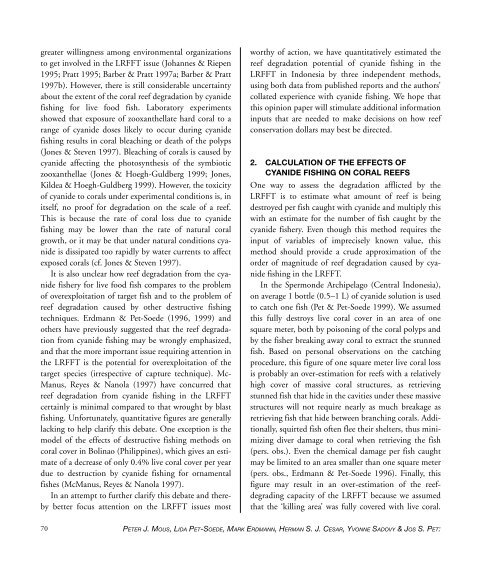Create successful ePaper yourself
Turn your PDF publications into a flip-book with our unique Google optimized e-Paper software.
greater willingness among environmental organizations<br />
to get involved in the LRFFT issue (Johannes & Riepen<br />
1995; Pratt 1995; Barber & Pratt 1997a; Barber & Pratt<br />
1997b). However, there is still considerable uncertainty<br />
about the extent <strong>of</strong> the coral reef degradation by cyanide<br />
fishing for live food fish. Laboratory experiments<br />
showed that exposure <strong>of</strong> zooxanthellate hard coral to a<br />
range <strong>of</strong> cyanide doses likely to occur during cyanide<br />
fishing results in coral bleaching or death <strong>of</strong> the polyps<br />
(Jones & Steven 1997). Bleaching <strong>of</strong> corals is caused by<br />
cyanide affecting the photosynthesis <strong>of</strong> the symbiotic<br />
zooxanthellae (Jones & Hoegh-Guldberg 1999; Jones,<br />
Kildea & Hoegh-Guldberg 1999). However, the toxicity<br />
<strong>of</strong> cyanide to corals under experimental conditions is, in<br />
itself, no pro<strong>of</strong> for degradation on the scale <strong>of</strong> a reef.<br />
This is because the rate <strong>of</strong> coral loss due to cyanide<br />
fishing may be lower than the rate <strong>of</strong> natural coral<br />
growth, or it may be that under natural conditions cyanide<br />
is dissipated too rapidly by water currents to affect<br />
exposed corals (cf. Jones & Steven 1997).<br />
It is also unclear how reef degradation from the cyanide<br />
fishery for live food fish compares to the problem<br />
<strong>of</strong> overexploitation <strong>of</strong> target fish and to the problem <strong>of</strong><br />
reef degradation caused by other destructive fishing<br />
techniques. Erdmann & Pet-Soede (1996, 1999) and<br />
others have previously suggested that the reef degradation<br />
from cyanide fishing may be wrongly emphasized,<br />
and that the more important issue requiring attention in<br />
the LRFFT is the potential for overexploitation <strong>of</strong> the<br />
target species (irrespective <strong>of</strong> capture technique). Mc-<br />
Manus, Reyes & Nanola (1997) have concurred that<br />
reef degradation from cyanide fishing in the LRFFT<br />
certainly is minimal compared to that wrought by blast<br />
fishing. Unfortunately, quantitative figures are generally<br />
lacking to help clarify this debate. One exception is the<br />
model <strong>of</strong> the effects <strong>of</strong> destructive fishing methods on<br />
coral cover in Bolinao (Philippines), which gives an estimate<br />
<strong>of</strong> a decrease <strong>of</strong> only 0.4% live coral cover per year<br />
due to destruction by cyanide fishing for ornamental<br />
fishes (McManus, Reyes & Nanola 1997).<br />
In an attempt to further clarify this debate and thereby<br />
better focus attention on the LRFFT issues most<br />
worthy <strong>of</strong> action, we have quantitatively estimated the<br />
reef degradation potential <strong>of</strong> cyanide fishing in the<br />
LRFFT in Indonesia by three independent methods,<br />
using both data from published reports and the authors’<br />
collated experience with cyanide fishing. We hope that<br />
this opinion paper will stimulate additional information<br />
inputs that are needed to make decisions on how reef<br />
conservation dollars may best be directed.<br />
2. CALCULATION OF THE EFFECTS OF<br />
CYANIDE FISHING ON CORAL REEFS<br />
One way to assess the degradation afflicted by the<br />
LRFFT is to estimate what amount <strong>of</strong> reef is being<br />
destroyed per fish caught with cyanide and multiply this<br />
with an estimate for the number <strong>of</strong> fish caught by the<br />
cyanide fishery. Even though this method requires the<br />
input <strong>of</strong> variables <strong>of</strong> imprecisely known value, this<br />
method should provide a crude approximation <strong>of</strong> the<br />
order <strong>of</strong> magnitude <strong>of</strong> reef degradation caused by cyanide<br />
fishing in the LRFFT.<br />
In the Spermonde Archipelago (Central Indonesia),<br />
on average 1 bottle (0.5–1 L) <strong>of</strong> cyanide solution is used<br />
to catch one fish (Pet & Pet-Soede 1999). We assumed<br />
this fully destroys live coral cover in an area <strong>of</strong> one<br />
square meter, both by poisoning <strong>of</strong> the coral polyps and<br />
by the fisher breaking away coral to extract the stunned<br />
fish. Based on personal observations on the catching<br />
procedure, this figure <strong>of</strong> one square meter live coral loss<br />
is probably an over-estimation for reefs with a relatively<br />
high cover <strong>of</strong> massive coral structures, as retrieving<br />
stunned fish that hide in the cavities under these massive<br />
structures will not require nearly as much breakage as<br />
retrieving fish that hide between branching corals. Additionally,<br />
squirted fish <strong>of</strong>ten flee their shelters, thus minimizing<br />
diver damage to coral when retrieving the fish<br />
(pers. obs.). Even the chemical damage per fish caught<br />
may be limited to an area smaller than one square meter<br />
(pers. obs., Erdmann & Pet-Soede 1996). Finally, this<br />
figure may result in an over-estimation <strong>of</strong> the reefdegrading<br />
capacity <strong>of</strong> the LRFFT because we assumed<br />
that the ‘killing area’ was fully covered with live coral.<br />
70<br />
PETER J. MOUS, LIDA PET-SOEDE, MARK ERDMANN, HERMAN S. J. CESAR, YVONNE SADOVY & JOS S. PET:


















